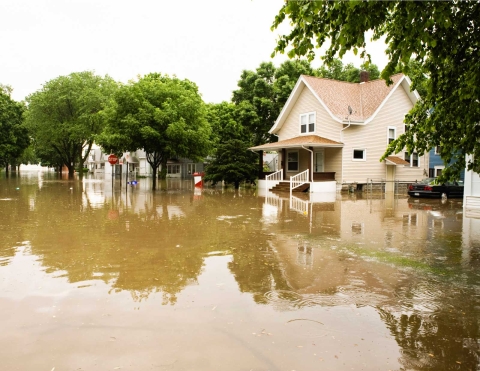NACo Legislative Analysis: Build Back Better Act
Upcoming Events
Related News
Jump to Section |

|
Agriculture & Rural Affairs
Invests in Rural America | $10.96 Billion
Counties would be able to apply for a broad range of programs that support rural America, including:
- $97 million through FY 2031 for rural water and wastewater grants in persistent poverty localities through U.S. Department of Agriculture (USDA)
- Provides an additional $970 million through FY 2031 to replace lead service lines under the Rural Development program through USDA
- $200 million through FY 2031 as loans for the Rural Energy Savings Program in persistent poverty localities through USDA
- $9.7 billion through FY 2031 in loans and loan guarantees for Rural Electric Cooperatives, which includes counties that have been a Rural Utilities Service Electric Loan Borrower through USDA
ESTABLISHES A NEW RURAL PARTNERSHIP PROGRAM | $873 MILLION
The bill would establish a new Rural Partnership Program through USDA, which aims to enhance rural communities’ access to federal community and economic development funding by providing flexible grants and technical assistance to a range of entities, including county governments. The competitive grant program targets micropolitan areas with populations between 10,000-50,000 residents.
Counties support holistic approaches to rural development and innovative approaches for building community capacity and introducing additional economic enhancement opportunities to rural businesses.
 |
Community, Economic & Workforce Development
Invests in Affordable Housing | $150 Billion
The bill would provide a total of $150 billion for affordable housing, including funding for the following U.S. Department of Housing and Urban Development (HUD) programs:
- $3.05 billion for the Community Development Block Grant (CDBG) program, including $500 million for a new Manufactured Housing Community Improvement Program
CDBG provides increased opportunities for elected officials to plan, implement and evaluate local community development and housing assistance programs.
- $24 billion for Housing Choice Vouchers and supportive services, including $7.1 billion for those experiencing or at-risk of homelessness and survivors of domestic violence and human trafficking
- $1 billion for Project Based Rental Assistance
- $25 billion for the HOME Investment Partnerships Program, including $15 billion to preserve and create affordable rental homes
The HOME Investment Partnerships Program builds upon the significant capacity and experience of county and other local and state governments to design and implement affordable housing programs for low and moderate-income persons. Counties are supportive of strategies that preserve the supply of low-income housing stock.
The legislation would also establish and fund several new affordable housing programs within HUD for which counties would be eligible to apply, including:
- $3 billion for a new Community Restoration and Revitalization Fund, which would fund competitive grants to perform affordable housing and neighborhood revitalization activities in rural, suburban and urban communities, including those experiencing blight and abandonment. Counties that partner with local nonprofits would be eligible to apply for funding under the program.
- $10 billion for a new First-Generation Down-Payment Assistance Program, which would fund formula grants to states and competitive grants to counties and other eligible entities to provide financial assistance to qualified homebuyers for down payment and closing costs, as well as costs to reduce the interest rate on the purchase of an eligible home. The financial assistance could not exceed the greater of $20,000 or 10 percent of the purchase price of the home.
- $1.75 billion for a new Unlocking Possibilities Program, which would fund two separate competitive grant programs, both of which would be aimed at developing, improving and implementing housing plans and community development strategies. Counties would be eligible to apply for funding under the program.
Strengthens Lead-Based Paint Hazard Control | $3.4 Billion
Counties would be eligible to receive funding from HUD for lead-based paint hazard control and housing-related health and safety hazard mitigation in the housing of lower-income families.
Permanent Boost for Low-Income Housing Tax Credit Properties
The bill would provide a permanent 50 percent basis boost for Low-Income Housing Tax Credit (LIHTC) properties that restrict the rent of at least 20 percent of their residential units to 30 percent of the area median income or the federal poverty line, whichever is greater. States must allocate at least 8 percent of their housing credit allocation to these properties.
The following limitations to the basis boost apply:
- For the 9 percent credit, a housing credit agency may not use more than 13 percent of the state’s housing credit ceiling on these properties
- For the 4 percent credit, a state cannot issue more than 8 percent of its private activity bond (PAB) volume cap on these properties
Counties support an increase in the supply of affordable housing through the expansion of federal housing tools, including the Low-Income Housing Tax Credit Program.
Creates a national comprehensive paid family and medical leave program
The bill would establish a new paid family and medical leave program, administered by the U.S. Social Security Administration. The program would provide eligible workers up to four weeks of paid leave per year for the birth or adoption of child, to care for a sick family member or to recover from an illness, beginning in 2024. All workers, including full- and part-time workers and self-employed workers, in both the public and private sector, would be eligible for the benefit.
States that currently have paid leave programs in place would be eligible for reimbursement by the federal government for the total cost of the program. Employers that sponsor a paid leave program would be eligible to be reimbursed for 90 percent of the cost of the program, up to four weeks. After 2024, the average weekly earnings would be indexed to wage growth.
Increases Funding for Workforce Development | $4.5 Billion
The bill would provide $4.5 billion for Workforce Innovation and Opportunity Act (WIOA) Title I programs within the U.S. Department of Labor (DOL), broken down as follows:
- $2 billion for Dislocated Workers Worker Employment and Training Activities
- $1 billion for Adult Worker Employment and Training Activities
- $1.5 billion Youth Workforce Investment Activities
WIOA is a vital funding source for workforce development that helps counties tackle and overcome challenges facing both job seekers and employers.
Expands Access and Opportunities to Apprenticeships | $1 Billion
The bill would provide DOL with $1 billion for registered apprenticeship, youth apprenticeship and pre-apprenticeship programs. Of this total, $500 million would be reserved for programs that serve individuals with barriers to employment.
Counties are supportive of new and expanded training and employment opportunities for residents.
Enhances Reentry Employment Opportunities | $500 MILLION
The bill would provide $500 million for DOL's Reentry Employment Opportunities program. Of this total, $125 million would be reserved for competitive grants to national and regional intermediaries for activities that prepare justice-involved young adults and those that have dropped out of school for employment.
Establishes A New Grant Program for Industry or Sector Partnerships | $5 Billion
The bill would establish a new $5 billion competitive grant program, administered by DOL, to expand employment and training activities for high-skill, high-wage or in-demand industry sectors or occupations. Of the funding provided, $250 million is reserved for state and local boards to support partnerships in local areas with high unemployment rates, percentages of dislocated workers or levels of individuals with barriers to employment.
Establishes A New Grant Program To Support The Direct Care Workforce | $1 Billion
The bill would establish a direct care workforce grant program, administered by DOL, which would provide competitive grants to provide competitive wages, benefits and other supportive services to direct care workers. The grants could also be used to develop and implement recruitment, retention and training programs for direct care workers. Local workforce development boards and area agencies on aging would be eligible to apply for funding under the program.
Invests In Employment and Training Activities For Climate Resilience And Mitigation Industries | $4.3 Billion
The bill would provide DOL with $4.3 billion for employment and training activities in climate resilience and mitigation industries. Funding under this umbrella would be provided for the following programs of importance to counties:
- $450 million for the YouthBuild program to support activities aligned with opportunities in industries related to climate resilience or mitigation
- $1 billion to create or expand pre-apprenticeship and registered apprenticeship programs in industries related to climate resilience or mitigation
- $450 million to create or expand registered apprenticeship programs in climate-related nontraditional apprenticeship occupations
- $350 million for pre-apprenticeship and registered apprenticeship programs that serve a high number of individuals with barriers to employment or nontraditional apprenticeship populations
- $1 billion for the Reentry Employment Opportunities program to support activities aligned with opportunities in industries related to climate resilience or mitigation
- $350 million to provide in-school and out-of-school youth with paid work experiences
Increased Investments in the Economic Development Administration | $5 Billion
The bill would provide $5 billion to the Economic Development Administration (EDA). Of this total, counties would be eligible to receive funding under the following programs:
- $3.36 billion for EDA’s Economic Adjustment Assistance Program to develop regional economic growth clusters, including grants for technical assistance, planning and predevelopment activities
- $480 million for EDA’s Economic Adjustment Assistance Program to provide grants for technical assistance, planning and predevelopment activities to energy and industrial transition communities
- $1.2 billion for a new Recompete Grants for Persistently Distressed Communities program, which would award grants to alleviate economic distress and support long-term comprehensive economic development and job creation
EDA is a critical resource, particularly for rural counties, in providing essential competitive grants for job creation, economic recovery and planning.

|
Environment, Energy & Land Use
Mitigates Air Pollution | $17.8 Billion
Counties would be eligible to apply for funding for a broad range of programs that aim to mitigate the impacts of air pollution. Funding would include:
- $2.625 billion through FY 2031 to combat air pollution at ports as competitive grants through U.S. Environmental Protection Agency (EPA)
- $7 billion through FY 2024 for greenhouse gas reduction in low-income and disadvantaged communities as competitive grants through EPA
- $2 billion through FY 2024 to support the purchase, installation, or operation of publicly available equipment to charge or fuel light-duty zero-emission vehicles as competitive grants through EPA
- $150 million through FY 2031 as competitive grants for community wildfire air through EPA
- $60 million through FY 2031 in competitive grants, rebates and loans for diesel emissions reductions through EPA
- $50 million through FY 2031 as competitive grants for multipollutant monitoring stations to expand the national ambient air quality monitoring network through EPA
- $37.5 million through FY 2031 to address air pollution at schools through EPA
- $4.75 billion through FY 2031 in climate pollution reduction grants through EPA
- $17 million as competitive grants for state and local governments to reduce greenhouse gas emissions that results from domestic electricity generation through EPA
Counties recognize the need for ongoing and sustained action regarding air quality involving all stakeholders at the international, federal, state, and local levels of government. The transport of air pollutants is a national and international problem that know no political boundaries. Air pollutants can have a significant impact on human health, the economic vitality of communities, natural resources and recreation areas, quality of life and the ecological balance of the world.
Addresses Hazardous Materials | $95 Million
Counties would be eligible to apply for competitive grants through EPA to reduce waste in communities to construct, expand, or modernize recycling infrastructure.
Counties recognize that improper management of solid and hazardous waste is a national problem, which endangers public health by contributing to air, water and land pollution. Local governments are integral to waste management, especially through establishing waste reduction and recycling programs.
Reduces Lead In Clean Drinking Water | $9 Billion
Counties would be eligible to apply for competitive grants, adminstered by EPA, through FY 2026 for full-service line replacement to install and maintain lead filtration stations at schools and childcare programs.
Counties recognize that the availability of an adequate supply of clean water is vital to our nation. Water quality degradation can impose human health risks through contaminated drinking water supplies, diseased fish, and unsafe or polluted water bodies used for recreation, and can lead to the loss of valuable wildlife habitat. Furthermore, counties support integrated and cooperative programs for protecting water quality that place responsibility on each level of government.
Promotes Clean Energy | $1.1 Billion
The bill would provide $300 million in funding to support state and local government’s retrofit building to achieve the latest building energy codes for residential buildings. Additionally, the bill would provide $800 million in grantsto facilitate the siting of interstate electricity transmission lines. Counties would be able to apply to both programs and receive funding through Department of Energy.
Counties support a comprehensive and integrated approach to a national energy policy that accelerates development, research and incentives for alternative and renewable energy, clean energy, energy efficient programs, and clean coal technologies, among other things.
Promotes Environmental Equity | $8.27 Billion
Counties would be eligible to apply for funding for a broad range of programs that promote environmental equity. Funding would include:
- $3 billion through FY 2026 for community climate incentive grant program
- $2.37 billion through FY 2026 for competitive grants for the neighborhood access and equity program administered by Federal Highway Administration (FHA)
- $2.8 billion through FY 2026 for environmental and climate justice block grants through EPA
- $100 million through FY 2026 in direct, competitive grants to localities to create and enhance access to parks or outdoor recreation in urban areas through the National Park Service (NPS)
Counties are uniquely positioned to serve as stewards for environmental justice and equity through the implementation of best practice policies that not only combat climate change at large, but ensure vulnerable populations are not subject to disproportionate harm
 |
Finance & Intergovernmental Affairs
Raises the cap on the State and Local Tax Deduction
The bill would raise the cap on the state and local tax (SALT) deduction from $10,000 to $80,000 and extend this cap through 2030. The $80,000 SALT cap amount would also apply to the 2021 tax year. For 2031, the SALT deduction cap would be set at $10,000.
Counties believe that the federal tax code should retain the deductibility of all state and local taxes, particularly the property tax, and it should reinstate the deductibility of sales taxes. NACo opposes any requirements that place the burden of responsibility on counties to determine and specify on real property tax bills the deductibility of those taxes and also opposes any requirement to report to the Internal Revenue Service the amount of taxes paid by each taxpayer.

|
Health
Enacts the Medicaid Reentry Act
The Medicaid Reentry Act amends the Federal Medicaid Inmate Exclusion policy (MIEP) by authorizing incarcerated individuals to receive services covered by Medicaid 30 days prior to their release from jail or prison. This provision would take effect 2 years after the bill’s enactment.
The Medicaid Inmate Exclusion policy allows individuals to re-enroll in Medicaid benefits 30 days prior to release would allow for continuous health care coverage and access to necessary behavioral health and addiction treatment that will alleviate the fiscal strains on county systems while making local communities safer and healthier.
Requires states to extend postpartum services from 60 days to 12 months
The legislation would require state Medicaid programs to provide 12 months of continuous Medicaid and Children’s Health Insurance Plan (CHIP) eligibility to both postpartum women and children. The provision would take effect 1 year after the bill’s enactment.
As key administrators of the local health safety net counties are crucial stakeholders in reducing rates of maternal mortality across the nation. The provision of continuous health care coverage for post-partum women and children reduces health disparities, reduces the incidence of infant and mortality and lessens the strain on county health systems who provide services for the uninsured and medically indigent.
Permanently extends the Money Follows the Person Program
The bill would permanently extend the Money Follows the Person Program to help transition individuals out of institutions and into Home and Community-Based Services (HCBS).
The Money Follows the Person program helps counties fill coverage gaps and provide wraparound services to residents. Counties play a central role in the federal-state- and local partnership for financing and administering Medicaid services to residents, including community-based long-term care.
Extends the temporary increase to the federal medical assistance percentage (FMAP)
The bill would extend the temporary increase to the federal medical assistance percentage (FMAP) authorized under the Families First Coronavirus Relief Act (FFCRA) after the end of the Public Health Emergency (PHE). The FFCRA increased Medicaid FMAP to states during the PHE by 6.2 percent. Instead of immediately reducing this increase once the PHE ends, the FMAP increase will be phased down to 3 percent on April 1, 2022, and 1.5 percent beginning on July 1, 2022. The FMAP increase would end completely on September 20, 2022.
Increases in the federal medical assistance percentage assist counties in effectively mitigating the surplus of low-income or indigent residents enrolling in the Medicaid program and utilizing local health services, and continue to provide critical treatment and care for those suffering with a COVID-19 and other infectious diseases and chronic conditions.
Increases the FMAP for Medicaid Expansion
The bill would increase the FMAP for Medicaid expansion from 90 percent to 93 percent through 2025 to help Medicaid expansion states maintain expanded coverage.
The Affordable Care Act strengthens the federal, state and local partnership for the Medicaid program and provides states with the option to expand coverage to low-income adults without children. Medicaid expansion also helps counties deliver better care for justice-involved individuals, qualifying them for access to necessary treatment and reducing the risk of recidivism.
Creates a permanent option for community-based mobile crisis intervention services to be covered under Medicaid
The mobile crisis service option for state Medicaid programs was authorized by the ARPA and slated to begin on April 1, 2022, and end on March 31, 2027. Under this provision, this state Medicaid option would become permanent, instead of ending on March 31, 2027.
Crisis intervention services are a critical tool to reducing the number of individuals with behavioral and mental disorders in the justice system while also increasing the availability of services in local communities; and Medicaid provides a sustainable mechanism for this type of care delivery. This provision would create a sustainable stream of federal funding for county health, behavioral health and justice partnerships to respond to mental health and substance use emergencies.
Invests in capital projects to support local health facilities | $1 Billion
The bill would provide $1 billion in funding through the U.S. Department of Health and Human Services (HHS) for new grants or cooperative agreements that can be used for health center facility alteration, renovation, remodeling, expansion, construction and other capital improvement costs.
Counties invest approximately $83 billion annually in community health and hospitals. Federal assistance on capital improvements to these facilities will support counties in expanding the capacity of local health care to provide services to residents.
Increased investments in the National Health Service Corps | $650 million
The bill would provide $650 million in funding through the U.S. Department of Health and Human Services (HHS) for the National Health Service Corps, which provides scholarships and loan repayment assistance to qualified health care providers in exchange for their service in underserved areas across the country.
Workforce shortages in every sector of health care and public health place counties and our nation at a disadvantage in our response to COVID-19 and other ongoing and emerging health threats. The National Health Service Corps helps to rebuild the local health workforce in the most vulnerable communities.
Authorizes permanent funding for the Children’s Health Insurance Program under the Centers for Medicare and Medicaid Services (CMS)
The Children’s Health Insurance Program is a key mechanism for expanding health care coverage and access for county residents, which reduces the number of uninsured and indigent individuals and improves health outcomes.
 |
Human Services & Education
Invests in child anti-hunger programs | $9 Billion
The bill would increase access to the U.S. Department of Agriculture (USDA) National School Lunch and School Breakfast programs in high-poverty schools through FY 2027.
Additionally, the bill would expand the Summer Electronic Benefit Transfer (EBT) program nationwide in FY 2023 and FY 2024. Eligible low-income children would receive $65 in monthly Supplemental Nutrition Assistance Program benefits to make up for school meals missed during the summer. States and counties would be eligible for $50 million in capacity building grants to support the development of the program, which is administered by USDA.
Counties support increased funding and administrative flexibilities within federal nutrition programs to ensure that all children have access to healthy meals at no-costâ¯in school, at child care and during the summer months.
Short-term extension of the expanded Child Tax Credit and Earned Income Tax Credit | $200 Billion
The bill would increase the value of the Child Tax Credit (CTC) as authorized under the American Rescue Plan Act (ARPA). Eligible families (earning up to $150,000 annually) with children receiving $3,000 per child ($3,600 for children under age 6) for the 2021 tax year. In addition to increasing the value, the bill would permanently extend the full refundability of the CTC, which was also authorized temporarily under ARPA, to ensure that very low-income families continue to qualify for the full credit in the long term.
ARPA also temporarily increased the value of the EITC for childless workers by up to $1,000 and expanded the minimum and maximum age for claiming the credit. BBB would extend these changes for the 2022 tax year. The bill would include $1 billion in administrative funding for the Department of Treasury to support efforts to increase eligible families in the expanded tax credits, including intergovernmental cooperative agreements with states and local governments awards to local governments for outreach efforts.
Counties support provisions to permanently expand the CTC and EITC, which are powerful tools for combatting poverty amongst our vulnerable residents, especially children.
New universal preschool and affordable child care program | $400 Billion
The bill would authorize an optional federal-state partnership, administered by the Department of Health and Human Services (HHS), guaranteeing access to affordable child care for working parents, through FY 2028. The program would involve a 3-year phase-in in which the federal government provides funds help states meet wage, quality and licensing system requirements to ensure adequate supply of affordable care, after which states would begin meeting various match and maintenance of effort requirements. Once fully implemented, families earning up to 250 percent of State Median income would pay a sliding scale co-pay capped at 7 percent of household income for children under age 6. Quality dollars would be eligible to support child care facilities construction and improvements.
The bill would authorize six-years of funding for an optional federal-state partnership to ensure universal access to high-quality preschool education for 3- and 4-year-olds via a mixed delivery system (meaning eligible providers include Head Start agencies, local educational agencies and licensed child care providers). States would begin contributing a 10 percent non-federal match in the fourth year of the program, gradually increasing to 40 percent in FY 2028.
In states that do not participate in the new programs, localities—including county governments—would have the option to apply directly for funds. Additionally, HHS would provide additional Head Start funding for any state that opts out of new initiatives.
Counties play a major role in shaping early childhood systems and investing in core services for children, including by administering the federal Child Care and Development Fund in eight states and serving as Head Start grantees across the nation. We support federal initiatives to help counties develop and expand voluntary early childhood and parent education and to expand the availability of child care subsidies for low-income families. We urge the federal government to provide sufficient technical assistance and administrative funding for local governments participating in or implementing new child care investments and to require state consultation with localities throughout implementation.
Increased Investments for PELL GRANTS AND HIGHER EDUCATION | $20 Billion through FY 2025
The bill would increase the maximum Pell Grant award by $550 through FY 2025 and provide $500 million in college student retention and completion grants through the Department of Education (ED). It would also invest in grant programs to help train new teachers, address the teacher shortage and prepare teachers to meet the needs of students with disabilities.
The county role in the post-secondary education sector varies, however, counties are critical actors in administering programs and services that comprehensively address education and workforce development. According to the American Association of Community Colleges, there are 986 public community colleges nationwide and local funds provide 17 percent of their revenues. Several local governments also fund four-year colleges. Counties support federal programs that preserve equal educational opportunities to our residents, including Pell grants, which play a significant role in community college financial aid.
Funding to prevent abuse and neglect in older adults | $3 Billion
The bill would provide $1.4 billion for the Department of Health and Human Services (HHS) to support state and local Adult Protective Services (APS) functions and grant programs from FY 2023 through FY 2025. Additionally, it provides $1.6 billion from FY 2023 through FY 2025 for HHS grants to states to invest in post-acute and long-term care (LTC) worker recruitment and retention.
In many states, counties are responsible for operating Adult Protective Services (APS), while nationally counties own, operate and support 758 skilled nursing facilities and nursing homes. As our population rapidly ages, we have urged our federal partners to support, facilitate and provide adequate funding for county implementation of these ever-increasing costs and responsibilities.
New changes to the federal immigration system
The bill would allow certain individuals to receive temporary residency, along with work and travel authorization, in the United States for five years or through 2031. Individuals who have lived and worked in the United States for more than 11-years would be eligible to apply for these protections.
Additionally, the bill provides supplemental funds to U.S. Citizenship and Immigration Services for FY 2022 to increase administrative capacity for the immigration provisions in the bill and to reduce processing backlogs.
Finally, the bill would provide $70 million for migrant and seasonal farmworker programs under WIOA through FY 2026.
Counties urge Congress and the President to enact comprehensive immigration reform legislation that improves and simplifies the current legal immigration system, establishes an earned path to citizenship, and provides efficient avenues for immigrants to contribute to the workforce and local economies.

|
Justice & Public Safety
Investments to Support Community-Based Violence Intervention Initiatives | $2.5 Billion
The Department of Justice (DOJ) would receive $2.5 billion through FY2031 for competitive grants to state and local governments to support evidence-informed intervention strategies to reduce community violence, and to support training and technical assistance for effective approaches by localities.
Counties support increased federal funding for programs that permit communities to develop resources and services to protect family members and prevent violence, improve staff training and link programs in the health, behavioral health, self-sufficiency, child welfare, criminal justice, law enforcement and social service systems for effective treatment and prevention of community violence.
Strengthen Resilience under National Flood Insurance Program
The bill would forgive over $20 billion in National Flood Insurance Program (NFIP) debt and direct $600 million to support flood mapping programs under Federal Emergency Management Agency (FEMA), along with providing $600 million for a means-tested affordability program for policyholders with incomes up to 120 percent of area median income.
NFIP was created under the National Flood Insurance Act of 1968 to provide insurance coverage to property owners for damages and losses due to catastrophic flooding. Counties across the country utilize funding administered through the NFIP to develop mitigation plans to better prepare for future flooding.
Disaster Relief
The FEMA Administrator would be provided with the discretion to provide financial assistance to recipients of disaster recovery and mitigation grants from the Agency for the purchase of low-carbon materials, and incentives that encourage the use of low-carbon or net-zero energy infrastructure projects.
Counties support increased financial and technical assistance to local governments to help develop and implement local climate change adaption and mitigation plans and projects, including but not limited smart growth initiatives, mass transit development, acquisition of high efficiency fleet vehicles, renewable energy deployment installation of emerging micro-grid and energy storage infrastructure, protection of water supplies, and disaster planning and preparedness.
 |
Public Lands
Hazardous Fuels Reduction | $10.5 Billion
The bill would provide $10 billion to the U.S. Department of Agriculture (USDA) for hazardous fuels reductions within the wildland-urban interface (WUI) in the National Forest System (NFS) with an additional $4 billion earmarked for hazardous fuels removal projects outside the WUI but within the NFS. These projects would be primarily non-commercial in nature but developed collaboratively and any commercial sales limited to small diameter trees or biomass.
In addition to the $10 billion, the bill would provide another $500 million to the U.S. Department of the Interior (DOI) for wildland fire management to be used for improving and constructing firefighting facilities, purchase or lease of aircraft and other necessary equipment, fuels reduction projects and wildfire science research.
Counties believe federal, state and local governments must work together to combat the growing threat of wildfire through accelerated timber harvests, hazardous fuels reduction projects and post-fire recovery and restoration efforts.
Promotes Forest Restoration and Resilience Projects
The bill would promote forest restoration and invest in resilience projects through:
- $2 billion in USDA grants to states, tribes, counties and non-governmental organizations for forest restoration and resilience projects on non-federal lands
- $1.4 billion in USDA grants for wildland fire resilience and preparedness
- $2 billion to conduct landscape resilience and ecosystem restoration projects on National Park Service (NPS) and Bureau of Land Management (BLM)
- $500 million for direct grants with no cost-share or matching requirements to be distributed for restoration work on NPS and BLM lands
Counties believe federal lands agencies should utilize an appropriate mix of management practices including partnerships with state, tribal and local governments for pre-fire management, effective fire suppression, and restoration of federal forests and rangelands.
New funding to carry out plans under the Endangered Species Act | $180 million
The U.S. Fish and Wildfire Service (USFWS) would receive $180 million to develop and carry out recovery plans under the Endangered Species Act.
As coregulators and environmental stewards, counties believe the federal government should coordinate with state and local governments to decide jointly when and how to list species, designate critical habitat and plan and manage for species recovery and delisting.
Restores wildlife habitat | $250 million
The USFWS would receive $250 million to control invasive species, restore wildlife habitat and make infrastructure more resilient to climate change on both USFWS lands and state wildlife conservation areas.
Counties support a well-funded, coordinated and integrated management approach to invasive species eradication on public lands through early detection, the accelerated completion of all environmental documentation and better coordination between federal agencies and local partners to better protect environmental resources from the threats and devastating impacts of invasive species.
NPS Deferred Maintenance and Housing for Corps programs employees | $400 million
Under the bill, $400 million would be made available for deferred maintenance needs within the National Park System and for U.S. Department of the Interior employee housing for those employees participating in corps programs performing conservation and resilience work on federal lands.
Counties support increased funding for overdue capital and deferred maintenance projects in national parks, national forests, and other public lands. This includes funding to support roads, bridges, trails, campgrounds, visitor centers, interpretive projects, and related facilities.
Fossil Fuel Development
The bill would increase the royalty for onshore fossil fuel development on federal lands from 12.5 percent to 18.75 percent and the offshore fossil fuel royalty within federal waters is set at a minimum 14 percent. The bill would also create new bonding requirements for fossil fuel development on federal lands, increases inspection and other fees, and creates a new royalty for methane emissions, such as venting and flaring. The bill would also cancel petroleum leasing within the Arctic National Wildlife Refuge and bans new oil and gas leasing in federal waters along the Atlantic and Pacific Coasts and in the Eastern Gulf of Mexico.
Counties support the onshore and offshore leasing on federally owned lands and waters where appropriate to maximize the royalty revenue streams for natural resource conservation, recreation, restoration and protection programs. Federal agencies should reduce obstructions that cause significant project delays and costs, including conducting oil, gas and mineral lease sales on all federal lands categorized in their land use plans for such leasing.
Offshore renewable energy
The bill would allow the U.S. Department of the Interior to hold offshore renewable energy lease in federal waters along the Atlantic and Pacific Coasts and in the Eastern Gulf of Mexico.
Counties recognize that U.S. energy independence requires expanded alternative and renewable resources that are available on federal public lands and support the expanded use of solar, wind, water, and other traditional and renewable energy resources to provide secure, clean, affordable energy.

|
Telecommunications & Technology
Extension of the Emergency Connectivity Fund | $300 million
The bill would provide an extension of $300 million for the Emergency Connectivity Fund, which helps schools and libraries keep students, staff and patrons connected during the COVID-19 emergency. Any school or library that provides off-site broadband service and connected devices for students, staff and patrons who would otherwise lack access during the COVID-19 crisis are eligible for reimbursements of related equipment and internet service costs. The program is administered through the Federal Communications Commission (FCC).
Counties are on the front lines of mitigating the digital divide in order to tackle the “homework gap”. Federal assistance to provide equitable internet access in our communities will support county efforts to provide low- or no-cost internet services for residents in-need.
Increased investments in Next Generation 911 | $500 million
The bill would provide $500 million in additional funding for the integration and implementation of Next Generation 911, or new technology that allows the public to send digital data to 911 call centers or public safety answering points (PSAPs). Next Generation 911 will improve the capacity and resiliency of our nation’s 911 systems. This program is administered by the National Telecommunications and Information Administration (NTIA)
Counties play a central role in administering public safety services, including operating our local 911 call centers and hiring 911 operators. Federal assistance to upgrade our nation’s 911 call centers is essential to continuing to provide adequate emergency response services.
 |
Transportation
Invests in Affordable Housing Access Program | $10 Billion
The BBBA would provide $9.75 billion through competitive grants to local public transit agencies and other entities eligible for assistance through transit formula grants: 5307, Urbanized Areas Formula Grants; 5311, Formula Grants for Rural Areas; and 5339(c), Low or No Emissions Grants (LoNo). Funds would remain available through FY 2026 (with the exception of the supplemental LoNo funds, which would be available through FY 2028) to expand accessibility to affordable housing, including through the:
- Construction of new fixed guideway capital projects
- Construction of bus rapid transit projects that utilize zero-emission vehicles
- Establishment or expansion of high-frequency bus service utilizing zero-emission buses
- Purchase of zero-emission vehicles to expand service
- Expansion of service in urban or rural areas, including by providing reduced or free fares
- Renovation or construction of transit facilities in disadvantaged communities or where service benefits low-income passengers generally
- Accessibility expansions or enhancements for disabled passengers
- Fleet transition
Additionally, $150 million would be available for research, technical assistance and training for counties or local transit agencies in receipt of funds under Public Transportation Innovation Grants (49 U.S.C. 5312) and Technical Assistance and Workforce Grants (49 U.S.C. 5314) to support activities under these sections that promote the deployment of zero-emission transit assets in disadvantaged communities or rural areas.
Counties directly support 78 percent of public transit systems that keep our residents and urban passengers connected to vital institutions and services.
Community Climate Grants | $3 Billion
Counties could apply directly to USDOT for these competitive grants, at a federal share of up to 100 percent, to carry out eligible carbon reduction activities, including projects with the potential to:
- Significantly reduce transportation-related greenhouse gas emissions (GHG)
- Provide zero-emission transportation options
- Reduce single-occupant vehicle trips
- Advance carbon reduction strategies toward the 2050 net-zero GHG goal
Neighborhood Access and Equity Grants | $4 Billion
Counties could apply directly to USDOT for $2.37 billion in competitive grants at an 80 percent federal cost share to carry out projects that improve walkability, safety and affordable transportation options; mitigate or remediate negative communal efforts resulting from a transportation obstacle; and for planning and capacity building within disadvantaged or underserved communities. Eligible projects would include:
- Removing, remediating or reusing surface transportation assets that create obstacles to connectivity
- Replacing facilities obstructing connectivity with at-grade structures operating at lower speeds
- Constructing Complete Streets, multiuse trails and other active transportation networks
- Providing affordable access to essential destinations and other public spaces
- Constructing noise barriers
- Assessing transportation impacts on pollution and equity
- Developing local anti-displacement policies
- Conducting predevelopment activities
- Expanding transit planning to include representatives of underserved or disadvantaged communities
Additionally, $1.58 billion would be available, at a federal share of up to 100 percent, through FY 2026 for USDOT to competitively award funds to improve infrastructure in economically disadvantaged communities, defined as communities that are:
- Economically disadvantaged, underserved or areas of persistent poverty
- Parties in a community benefits agreement
- Subject to anti-displacement policies, community land trusts or an operational community advisory board
- Implementing plans to employ local residents impacted under this section
Passenger Rail Improvement, Modernizations, and Emissions (PRIME) Reduction Grants | $10 Billion
Local public transit agencies would be eligible for USDOT competitive PRIME grants to carry out eligible planning activities and high-speed rail capital corridor development projects to improve intercity passenger rail service at a 90 percent federal cost share. $1 billion of these funds would be available for planning activities.
Alternative Fuel and Low-Emission Aviation Technology Program | $294 million
Counties and airport sponsors could apply directly to USDOT for competitive grant funds to carry out projects at a 90 percent federal cost share that promote the manufacture and use of sustainable aviation fuels, as well as projects related to lowering aviation-related carbon emissions.
Funds would remain available through FY 2026 and would be appropriated in the following ways:
- $247 million for projects related to the “productions, transportation, blending, or storage sustainable aviation fuel”
- $47 million for projects with related to “low-emission aviation technologies”
- $6 million for USDOT to make awards under this section
In addition to our significant surface transportation responsibilities, including owning more roads and bridges than any other level of government, counties directly support 34 percent of public airports that keep Americans connected in every corner of the country and throughout the globe.
Facilitates National Environmental Policy Act (NEPA) reviews | $50 million
USDOT could use these funds to provide technical assistance and other guidance to eligible entities, including counties, in order to streamline and improve the NEPA review process.
USDOT could also provide funds directly to counties to carry out eligible activities to expedite reviews, including:
- Capacity building and related administrative expenses
- Facilitating the review process for proposed projects by defining scope or study areas; identifying impacts and reasonable alternatives; and preparing planning, such as relevant environmental studies and other documents
- Public engagement
To satisfy the 80 percent cost share, counties could use other federal or state grant funds, including any funds administered by DOT.
Streamlining the federal permitting process is a long-standing priority of America's counties, who bear the cost of delay as a result of overly burdensome environmental review processes. As public servants with significant infrastructure responsibilities, county officials urge federal policymakers to strike a balance between commonsense reforms to review processes and continued excellent stewardship of the environment.
Reimbursements for use of low-carbon materials in transportation projects | $900 million
Counties would be eligible for reimbursement from USDOT for the incremental cost between using low-embodied carbon materials (LECM) versus the cost of using traditional materials. LECM would be defined as materials identified by the U.S. Environmental Protection Agency as having lower levels of embodied carbon. Embodied carbon refers to the aggregate amount of greenhouse gas emissions associated with all stages of production.
As an additional incentive, any project eligible for reimbursement under this section would also become eligible for a 100 percent federal cost share.